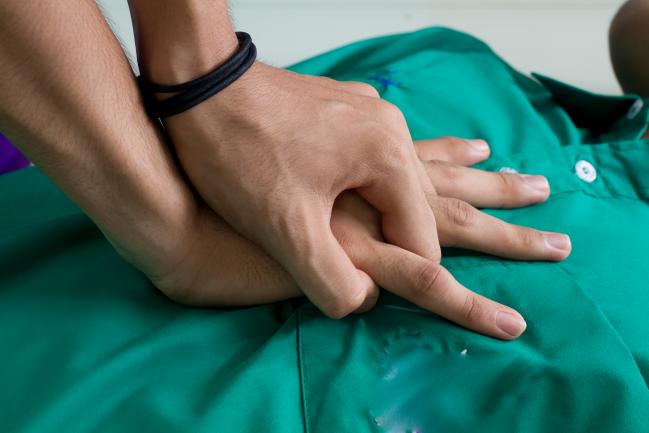Hands-Only CPR Linked With Significant Increase in Bystander Resuscitation in Sweden
Reassuringly, 30-day survival was similar between cardiac arrest victims treated with compression-only versus standard CPR over the 15-year study.

NEW ORLEANS, LA—Adoption of compression-only CPR in Sweden in 2011 has significantly increased the likelihood that bystanders will step in to perform chest compressions for someone experiencing cardiac arrest.
New data from more than 23,000 instances of cardiac arrest across Sweden over a 15-year period show that survival rates during the compression-only era are similar to those seen during the years when both chest compressions and rescue breathing were recommended for CPR.
According to Gabriel Riva, MD (Karolinska Institute, Stockholm, Sweden), who spoke with TCTMD here, Sweden updated its CPR guidance in 2011 and while they still recommend CPR with compression plus rescue breathing, there is now an option to do "hands-only" CPR if you are untrained, unable, or unwilling to perform rescue breaths. Riva will present the results of the study tomorrow during the American Heart Association’s Resuscitation Science Symposium.
According to Riva, compression-only CPR was proposed as a modification of standard cardiopulmonary resuscitation for two reasons. The first was that, at least in adults, maintaining cardiocerebral circulation is believed to sufficiently maintain enough blood flow to preserve brain function until emergency personnel arrive. A secondary reason was that bystanders unwilling to perform rescue breathing might be more comfortable performing chest compressions.
Riva et al’s analysis includes data on 23,169 subjects who suffered cardiac arrest between 2000 and 2014 and whose outcomes were reported to the Swedish Cardiac Arrest Registry. The registry captured approximately 90% of all cardiac arrests occurring in Sweden during this period, he told TCTMD. Over the 15 years of study, total rates of bystander CPR increased from 38% in 2000-2005 to 70% in 2011-2014. Looking specifically at compression-only CPR, rates here increased from 5% to 28% during the same period.
Importantly, no differences were seen in rates of 30-day survival in the compression-only CPR (13.6%) versus standard CPR (12.9%, P = NS).
“We haven’t proven that one method is better than the other, but there is indirect positive effects since [compression-only CPR] was associated with increased overall bystander CPR,” Riva told TCTMD. “What I would say is it is a ‘neutral result,’ which means we haven’t proven . . . that one strategy was superior to the other, but we have shown increased overall performance [of bystander CPR].”
The latest edition of the AHA Resuscitation Guidelines, released in 2015, recommends hands-only CPR for untrained bystanders. Riva, speaking with TCTMD, said he believes the Swedish results would likely be applicable to the United States and other countries.
Importantly, however, a compression-only CPR strategy is not supported in children, the AHA warns. As Riva explained, “It’s important to separate adults from children, because children more often have cardiac arrest due to asphyxia. So in children, rescue breathing is crucial, while in adults cardiac arrest is more likely to have cardiac causes, so [maintaining circulation] is more important.”
Rescue Breathing Still Important for Children
Indeed, in a separate study, also presented during the Resuscitation symposium, researchers led by Maryam Y. Naim, MD (Children’s Hospital of Philadelphia, PA), report that among children 18 years and younger, survival following standard CPR is greater than it is after compression-only CPR. But worryingly, Hispanic and African-American children in this cohort were significantly less likely to receive bystander CPR than white children. They also were more likely to receive compression-only versus conventional CPR. Children who received conventional CPR, including rescue breathing plus chest compressions, had a 60% greater chance of surviving and a 50% greater chance of being discharged from the hospital with favorable neurological outcomes compared with those given compression-only CPR.
As to why rescue breathing was less likely to be used in non-white children, the authors of this study, which was also published simultaneously in JAMA Pediatrics, note that similar disparities have also been observed among adults, as have racial disparities in the performance of any form of bystander CPR. “[Our] report suggests a potential target for intervention in African-American and Hispanic communities where a public health strategy can be undertaken to enhance bystander CPR in children,” Naim et al conclude.
According to Riva, in studies that have looked into the real and perceived barriers to performing CPR, the “key factors” tend to be “insecurity and confidence.”
People, said Riva, “have the worry that you’re not sure how to do it right or you have fear of inflicting harm, and I think that if you simplify the guidelines on how to perform CPR it makes people feel more confident in what they are doing and more likely to do it.” In surveys on this topic, he added, “disgust or fear of infectious diseases are actually rated lower than the fear of doing harm.”
Shelley Wood was the Editor-in-Chief of TCTMD and the Editorial Director at the Cardiovascular Research Foundation (CRF) from October 2015…
Read Full BioSources
Riva G. Increase in bystander cardiopulmonary resuscitation in Sweden during the last 15 years is mainly attributed to increased rates of "chest compression only" CPR. Presented at: American Heart Association Resuscitation Science Symposium. November 12, 2016. New Orleans, LA.
Disclosures
- Riva and Naim report having no disclosures.


Comments